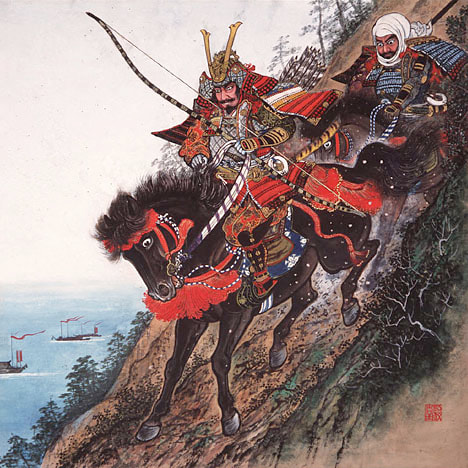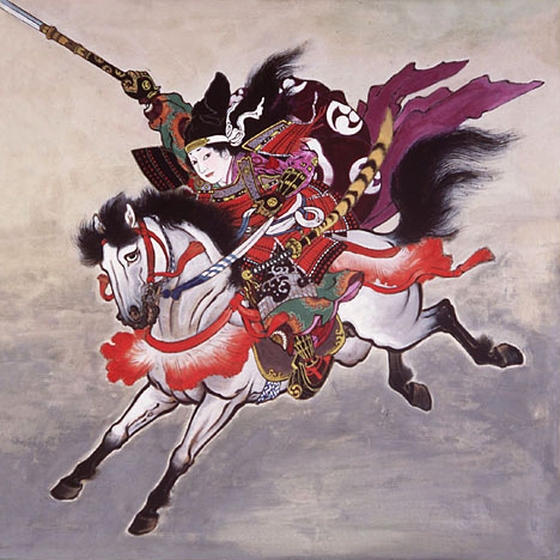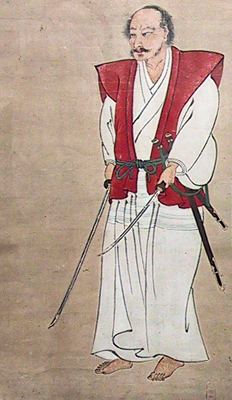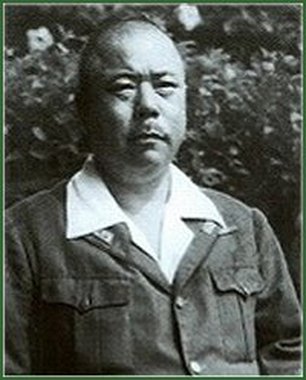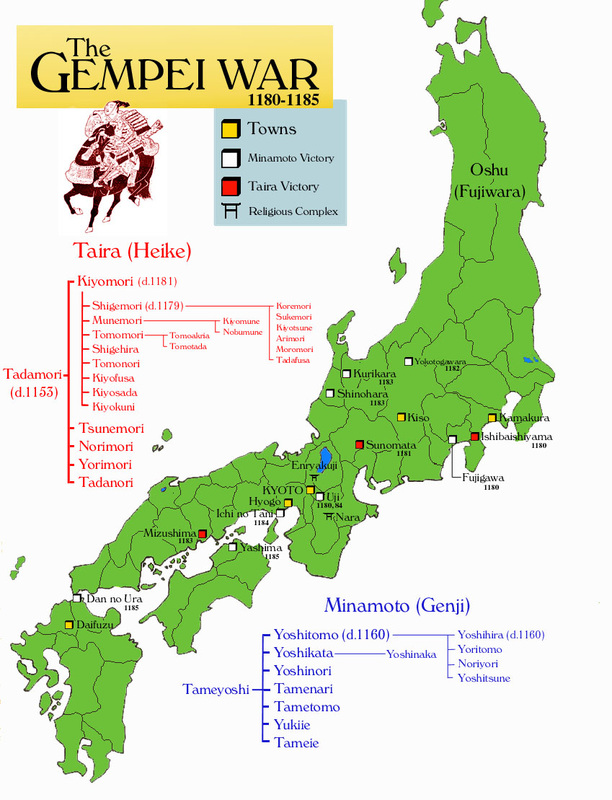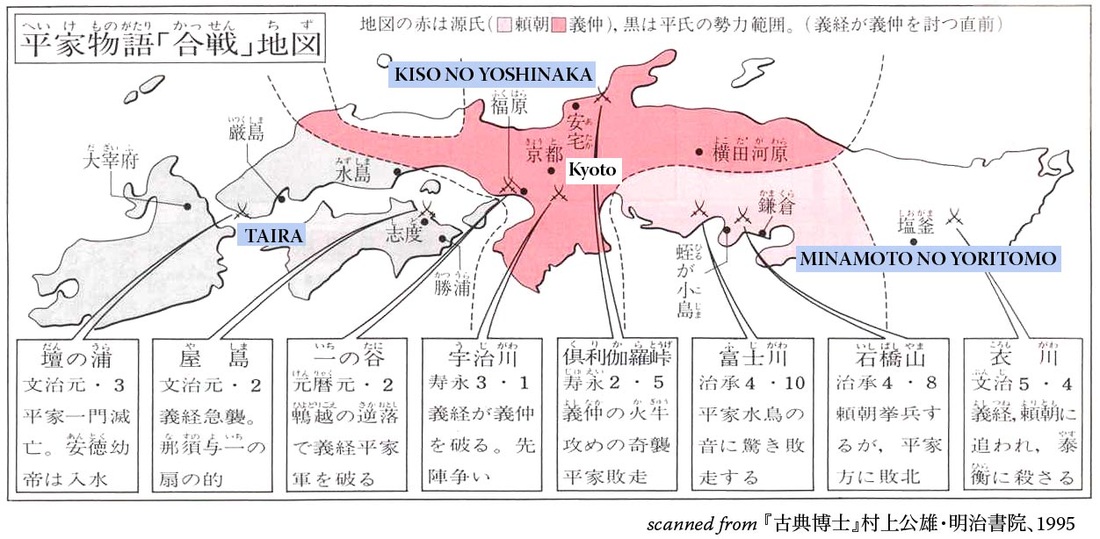The Japanese Warrior: History, Religion, and Philosophy
Minamoto Yoshitsune during his famous "Assault from the Cliff" as described in Chapter Nine, Section 12 of the Heike Monogatari. Image from Electric Samurai
On the right you see his faithful companion, the fighting-monk Musashibō Benkei.
___________________________________________________________________________
Visions of the Japanese warrior in his many forms loom largely through the history of East Asia and through popular sentiments of what being a warrior is all about. Martial arts and the profession of soldiery are described in Japan as a “path” or “way.” This implies that such disciplines are not reducible to technical skills, but represent an ideology. Indeed, a continual refrain from the distant past to the present is that the spirit of the warrior lies at the very heart of Japanese people and Japanese culture.
In this course, we seek to examine the character of the Japanese warrior throughout history to determine what constitutes the worldview of Japanese combatants and if such worldviews have maintained any consistency over time. More specifically, we will look at archetypical warriors using prototypical weapons in exemplary battles through famous literature, films, and historical accounts.
In this course, we seek to examine the character of the Japanese warrior throughout history to determine what constitutes the worldview of Japanese combatants and if such worldviews have maintained any consistency over time. More specifically, we will look at archetypical warriors using prototypical weapons in exemplary battles through famous literature, films, and historical accounts.
A stylized image of Tomoe Gozen, an exceptionally rare female warrior who serves Minamoto no Yoshinaka in the Tale of Heike
____________________________________________________________________________
Course Topics
The Divine Warrior of the Legendary Past: Yamatotakeru and the Kusanagi Sword
The Ancient Mounted Archer (Tsuwamono): Taira no Masakado and The Bow
The Samurai: Minamoto no Yoshitsune and the Sword
The Warrior Monk: Benkei/Takeda Shingen and the Naginata
The Ninja (Shinobi): Natori Masatake and the Kusari-gama
The Samurai II: Yamamoto Tsunetomo and the Sword
Warrior Philosophy: Bushidō, the Zen Swordsman, and the Virtue of Self-Sacrifice
The Infantryman: General Yamashita and the Rifle Bayonet
The Ace Pilot: Sakai Saburō and the Zero
WWII Holdouts and the Nisei Warrior
Miyamoto Musashi (1584-1645). He was the master of the two-sword fighting style, who was obsessed with Buddhist philosophy.
_______________________________________________________________________________
Key Questions for Our Investigation
· What motivates the fighting man of Japan through the ages?
· Is the Japanese warrior tradition dependent on the suppression of new weapon technologies?
· Is the samurai of old admired as a man of cultured refinement or as a person of simple tastes and pleasures?
· Are the conflicts which involved Japan's medieval Buddhist institutions generally of a religious or political nature?
· What is the role of pride for the fighting man?
· How would you describe the relationship between the individual and the group with regard to samurai and soldiers? Are they “team players” or “lone wolves”?
· To what extent does the “way of the warrior” become a spiritual worldview in and of itself?
· Does the apparent suicidal tendencies of Japanese warriors compromise their combat effectiveness?
· What pop cultural characters and themes (both East and West) borrow from the image of Japan's warriors?
· What are the key markers of a “good” fighter and “bad” fighter? Can we easily tell who are the good guys and who are the bad guys in the battles we consider?
· How does specific weaponry help to evoke a romantic fighting spirit with respect to the bushi?
_______________________________________________________________________________
Key Questions for Our Investigation
· What motivates the fighting man of Japan through the ages?
· Is the Japanese warrior tradition dependent on the suppression of new weapon technologies?
· Is the samurai of old admired as a man of cultured refinement or as a person of simple tastes and pleasures?
· Are the conflicts which involved Japan's medieval Buddhist institutions generally of a religious or political nature?
· What is the role of pride for the fighting man?
· How would you describe the relationship between the individual and the group with regard to samurai and soldiers? Are they “team players” or “lone wolves”?
· To what extent does the “way of the warrior” become a spiritual worldview in and of itself?
· Does the apparent suicidal tendencies of Japanese warriors compromise their combat effectiveness?
· What pop cultural characters and themes (both East and West) borrow from the image of Japan's warriors?
· What are the key markers of a “good” fighter and “bad” fighter? Can we easily tell who are the good guys and who are the bad guys in the battles we consider?
· How does specific weaponry help to evoke a romantic fighting spirit with respect to the bushi?
_______________________________________________________________________________
General Yamashita Tomoyuki, the controversial, if highly gifted, infantry commander in the the Second World War. He was nicknamed the "Tiger of Malay" for his bicycle-enabled blitz down the Malay peninsula in late 1941 into early 1942. Photo credit and biography: here
Resources for the Heike Monogatari
(Japan's most famous war tale and one of its most important works of literature)
Created by F.W. Seal
Prof. John Wallace's Excellent Overview Site for Heike Study
A concise, but useful, timeline of the Heian Period (794-1185)
- includes great chapter summaries, character descriptions, and visual aids
- probably the best English language aid available for navigating the wonderful, but complex landscape of this tale
A concise, but useful, timeline of the Heian Period (794-1185)
- has a very good summary of the Gempei War, which is the subject of the Tale of Heike
Bushido Thought Resources:
Bushido or Bull? by Karl Friday
Bushido: The Soul of Japan by Nitobe Inazo
_____________________________________________________
Bushido or Bull? by Karl Friday
Bushido: The Soul of Japan by Nitobe Inazo
_____________________________________________________
Other Resources:
Bowdoin College-Heiji Monogatari Emaki Interactive here
Osaka Castle Field Trip Video: Here
_____________________________________________________
Exemplary Student Creative Projects:
Izumi Yamamoto Nasu no Yoichi
Samantha Jay Samurai Death Poems
Conor McCarthy The Forgotten Heros of Dan-no-Ura (a virtual reality experience)
Yoshihiro Mori The Story of Yamato Takeru
Alberto Duthoy The Battle of Uji Bridge
Jessica Nguy The Warrior Monk Benkei
Gary Michael Noritsune's Blog
Mari Pikkarainen Yamato Takeru Comic
Lianet Cuella Benkei Project
